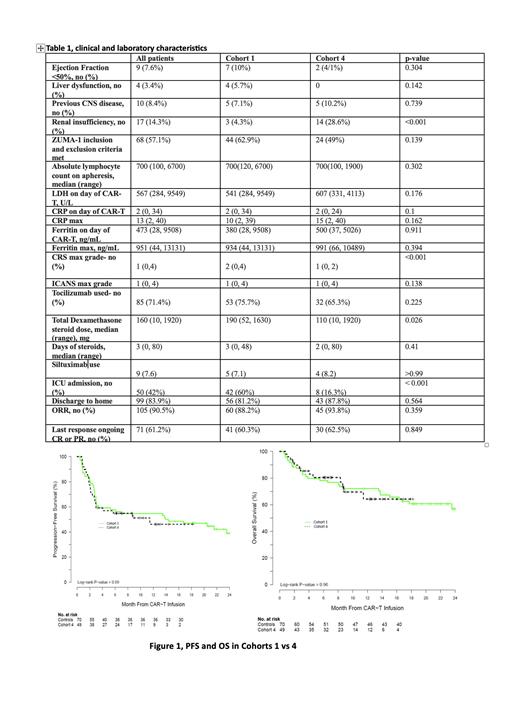Introduction: Axicabtagene ciloleucel (axi-cel) is a chimeric antigen receptor T-cell (CAR-T) therapy approved for treatment of relapsed/refractory (R/R) large B cell lymphoma (LBCL). The registrational phase I/II ZUMA-1 study Cohorts 1 and 4 addressed toxicity management in terms of cytokine release syndrome (CRS) and immune effector cell-associated neurotoxicity syndrome (ICANS) whereby tocilizumab and corticosteroids were deployed earlier in Cohort 4.(1,2) Although Cohort 4 consisted of only 41 patients, it demonstrated that earlier intervention resulted in significantly fewer cases of grade ≥3 CRS (2%) and ICANS (17%) and a lower cumulative dose of steroids. Furthermore, efficacy as determined by overall response rate (ORR) and complete response (CR) did not appear to be negatively impacted by earlier use of tocilizumab and corticosteroids. However, given the small number of patients in Cohort 4, concern has remained that earlier intervention may have a deleterious impact on CAR-T cell expansion, persistence, and efficacy.
During the COVID-19 pandemic, with overwhelmed Intensive Care Units (ICUs) across the country, we adopted a Cohort 4 guided approach to CAR-T toxicity management with the hope of decreasing the need for ICU level of care following CAR-T infusion.
Herein, we present our single-institution, real-world experience since implementing an early intervention strategy with Cohort 4 and compare it with our previous Cohort 1 axi-cel recipients in terms of toxicity (CRS, ICANS, ICU utilization) and efficacy.
Methods: 119 patients receiving axi-cel CAR-T therapy for R/R LBCL are included in this single-institution, retrospective study with 70 in Cohort 1 and 49 in Cohort 4. The transition from a Cohort 1 to Cohort 4 approach occurred in March 2021. Thus, for Cohort 1 the data cut-off was February 2021 and for Cohort 4 it was after April 2021. The COVID pandemic and the lack of the ICU capacity was the initial chief rationale for transitioning to Cohort 4. This study was conducted following IRB approval and in accordance with the Declaration of Helsinki. R version 1.3.1099 (R-studio) was used for all statistical modeling. All statistical tests were 2-sided and conducted at the 0.05 level of significance.
Results: The median age was 62 (22-88) years-old, 35% female gender, 76% advanced stage III-IV disease, 22% with bulky ≥10cm disease, 71% with diagnosis of Diffuse LBCL, and 26% with more than three lines of previous therapy. The median follow-up time at analysis was 1.5 years. Laboratory parameters and comorbidities did not significantly differ between groups except for a higher incidence of renal insufficiency in the Cohort 4 group (28.6% vs 4.3%, p<0.001) (see Table 1). The median maximum grade CRS was significantly lower for Cohort 4 (2 vs 1, p<0.001) although the median grade of ICANS was not different. The utilization of tocilizumab and siltuximab was similar in both groups. The duration of steroid use was comparable in both; however, the total steroid use (dexamethasone equivalent) was notably lower in Cohort 4 (110 mg vs 190 mg, p=0.026). ICU admission following CAR-T infusion was much lower in Cohort 4 (16.3% vs 60%, p<0.001). Most patients (>80%) were discharged home after CAR-T therapy and did not need placement in a rehabilitation center or long-term facility. The ORR and ongoing responses were similar in both groups with nearly 90% achieving a response and 60% with an ongoing response. The cumulative incidence of relapse, PFS, and OS were not significantly different between the groups (see Figure 1).
Conclusion:
The use of an early toxicity intervention strategy based upon ZUMA-1 Cohort 4 in the real world results in significantly lower high-grade CRS, decreased cumulative steroid dose, and an 73% reduction in ICU utilization without significantly impacting efficacy in terms of incidence of relapse, PFS, or OS. Our real-world experience with the adoption of a Cohort 4 strategy suggests that patient morbidity may be greatly attenuated without compromising CAR-T therapy response. However, the need for longer follow-up to evaluate the impact early use of steroids has on CAR-T persistence and PFS at >5 years remains.
Disclosures
Yared:AAACTT (Board of Directors), NHLBI DSMB (Board member): Membership on an entity's Board of Directors or advisory committees; Institution research funding as a PI on pharma- sponsored clinical trials opened at the University of Maryland: Research Funding; University of Maryland: Current Employment; Sanofi, Incyte, Kadmon, Omeros: Consultancy. Hardy:American Gene Technologies: Other: Member DSMB; InCyte Corporation: Membership on an entity's Board of Directors or advisory committees; Kite/Gilead: Membership on an entity's Board of Directors or advisory committees. McGuirk:Gamida Cell: Research Funding; Bellicum Pharmaceuticals: Research Funding; Fresenius Biotech: Research Funding; Astellas Pharma: Research Funding; Novartis: Research Funding; Magenta Therapeutics: Consultancy; EcoR1 Capital: Consultancy; Allovir: Consultancy, Research Funding; Juno Therapeutics: Consultancy; Kite: Consultancy, Research Funding; Pluristem Therapeutics: Research Funding. Dahiya:Kite, a Gilead Company: Consultancy, Research Funding; Bristol Myers Squibb: Consultancy; Incyte: Consultancy; Adaptive Biotechnologies: Consultancy.


This feature is available to Subscribers Only
Sign In or Create an Account Close Modal